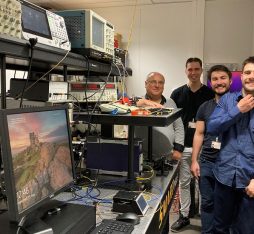Network throughput, which is of great interest to the general public, is just one aspect of its performance. , in particular, plays a key role in the quality of daily digital experiences: Excessive latency causes lag in online video games. Low latency may therefore prove critical for the proper functioning of certain emerging or future professional applications, such as the industrial metaverse and cloud robotics. How can we set up networks that are capable of delivering latency in a controlled, stable and secure way?
An architecture designed to improve latency
The answer is L4S, which stands for Low Latency, Low Loss and Scalable Throughput. This architecture was standardized by the IETF for use in Internet networks, and aims to optimize latency for sensitive applications. The technology originated from a partnership between Microsoft and Stanford University to address congestion issues in data centers. L4S is derived from that technology, and is designed for the Internet.
With L4S, networks can improve their response capacity, better manage queues and throughput, and provide a low latency service.
It is based on an method, applied to two queues simultaneously. Stéphane Tuffin and Joël Ky, R&D Engineers at Orange explain that “In this model, we must cover two coupled queues with two specific treatments: one for low latency traffic and the other for standard traffic. “By coupling queues, we can implement two latency management strategies while maintaining an even throughput distribution. Thanks to a marker, placed on packet headers, that indicates the queue fill rate, applications can adapt their throughput usage, while the network helps to distribute throughput evenly. It is more about distributing throughput evenly than prioritizing, but low latency is still controlled by reported flows that are identified as requiring low latency.
Experimenting with actual L4S rollouts
With L4S, networks can improve their response capacity, better manage queues and throughput, and guard against congestion issues which cause packet losses.
However, between the principle used as a basis for the technology’s design and what is actually observed during its implementation, the MOSAICO research project went one step further. Funded by the French National Research Agency (ANR), MOSAICO was launched at the end of 2019, when L4S was still in its infancy. The project brings together several academic and industrial partners, including Orange (project coordinator), the Lorraine Research Laboratory in Computer Science and its Applications (LORIA), Montimage and the University of Technology of Troyes (UTT). Its contributions can mainly be seen in two areas: “Following the initial ideas of L4S designers, we wanted to study the solution’s operation and performance in non-wired networks and in standard applications that are more demanding in terms of low latency, such as cloud gaming and videoconferencing.”
The need for advanced monitoring
Here are two key takeaways from this project:
- In theory, the performance promised under 1 millisecond of queuing delay for 99% of packets, but in reality, it is closer to 10 milliseconds for 95% of packets. To reach the highest level of efficiency, we need to further improve its design and configuration, and experiment with the use of AI in the queuing management algorithm.
- Ensuring a low-latency service has a significant impact on network monitoring. “At present, network latency monitoring is a non-subject, aside from a few technical statistics in the long run, but latency happens over very short periods and causes disruption that can persist over time. More accurate and dynamic solutions are needed to measure the delays experienced on a packet-by-packet basis. That’s why we used an in-band telemetry method to record information on packet performance, such as where and when they flow through the network, which is then retrieved by probes.” Such sophisticated monitoring tools are essential, in particular for professional applications.
Rollouts are moving forward in the application world
This technology still has some way to go before it can reach its full potential, but its benefits and added value are already being felt. Over the past few months, the L4S ecosystem has been steadily gaining popularity and momentum, in particular in the applications sector. Apple has been implementing L4S since iOS 17; as has Google via its BBRv2 Congestion Control Algorithm, while NVIDIA has introduced it in GeForce Now, its cloud gaming service, and in its CloudXR solution. Yet, L4S remains largely experimental in networks. The Wireless Broadband Alliance has launched a working group to investigate L4S support in Wi-Fi access points. Watch this space…
Latency refers to the delay needed for a data packet to be transmitted to and from a client and a server.
Active queue management combines several mechanisms designed to handle congestion points in IP networks.
 Stéphane Tuffin
Stéphane Tuffin
 Joël Roman Ky
Joël Roman Ky











